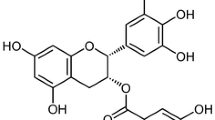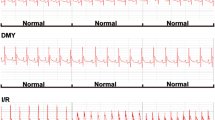Abstract
Epigallocatechin-3-gallate (EGCG), the major catechin derived from green tea, has been shown to modulate numerous molecular targets in the setting of inflammation. This study aimed to determine whether EGCG protects against regional myocardial ischemia/reperfusion (I/R) injuries and its underlying mechanisms involving the role of reperfusion injury salvage kinase (RISK) pathways (PI3K-Akt and ERK 1/2) and GSK-3β or apoptotic kinases (p38 and JNK). The rats were subjected to I/R injuries consisting of 30 min ischemia followed by 2 h reperfusion. EGCG (10 mg/kg, intravenously) was administered alone or along with wortmannin (PI3K inhibitor, 0.6 mg/kg, intravenously) 5 min before the onset of reperfusion. Wortmannin was administered 10 min before the reperfusion. Infarct size was measured at the end of the reperfusion. The phosphorylation of Akt, GSK-3β, and MAPK kinases (ERK1/2, P38 and JNK) was determined by Western blotting after 10 min of reperfusion. EGCG reduced the infarct size compared with the control (25.4 ± 9.2 versus 43.2 ± 8.2 %, p < 0.05). Wortmannin alone did not affect the infarct size, but abolished the EGCG-induced infarct size limiting effect, indicating that EGCG may protect the heart by modulating the PI3K-Akt. EGCG significantly enhanced the phosphorylation of Akt and GSK-3β but not ERK1/2, while it reduced that of p38 and JNK. These results suggest that EGCG has a protective effect against regional myocardial I/R injuries through activation of the RISK pathway and attenuation of p38 and JNK. EGCG may have cardioprotective effects in patients undergoing surgeries prone to myocardial I/R injuries.




Similar content being viewed by others
References
Andreka, P., J. Zang, C. Dougherty, T.I. Slepak, K.A. Webster, and N.H. Bishopric. 2001. Cytoprotection by Jun kinase during nitric oxide-induced cardiac myocyte apoptosis. Circulation Research 88: 305–312.
Aneja, R., P.W. Hake, T.J. Burroughs, A.G. Denenberg, H.R. Wong, and B. Zingarelli. 2004. Epigallocatechin, a green tea polyphenol, attenuates myocardial ischemia reperfusion injury in rats. Molecular Medicine 10: 55–62.
Argaud, L., O. Gateau-Roesch, O. Raisky, J. Loufouat, D. Robert, and M. Ovize. 2005. Postconditioning inhibits mitochondrial permeability transition. Circulation 111: 194–197.
Bell, J.R., P. Eaton, and M.J. Shattock. 2008. Role of p38-mitogen-activated protein kinase in ischaemic preconditioning in rat heart. Clinical and Experimental Pharmacology and Physiology 35: 126–134.
Bliksoen, M., M.L. Kaljusto, J. Vaage, and K.O. Stenslokken. 2008. Effects of hydrogen sulphide on ischaemia–reperfusion injury and ischaemic preconditioning in the isolated, perfused rat heart. European Journal of Cardio-Thoracic Surgery 34: 344–349.
Cabrera, C., R. Artacho, and R. Gimenez. 2006. Beneficial effects of green tea—a review. Journal of the American College of Nutrition 25: 79–99.
Chyu, K.Y., S.M. Babbidge, X. Zhao, R. Dandillaya, A.G. Rietveld, J. Yano, P. Dimayuga, B. Cercek, and P.K. Shah. 2004. Differential effects of green tea-derived catechin on developing versus established atherosclerosis in apolipoprotein E-null mice. Circulation 109: 2448–2453.
Chiari, P.C., M.W. Bienengraeber, P.S. Pagel, J.G. Krolikowski, J.R. Kersten, and D.C. Warltier. 2005. Isoflurane protects against myocardial infarction during early reperfusion by activation of phosphatidylinositol-3-kinase signal transduction: evidence for anesthetic-induced postconditioning in rabbits. Anesthesiology 102: 102–109.
Gharanei, M., A. Hussain, O. Janneh, and H.L. Maddock. 2013. Doxorubicin induced myocardial injury is exacerbated following ischaemic stress via opening of the mitochondrial permeability transition pore. Toxicology and Applied Pharmacology 268: 149–156.
Gomez, L., M. Paillard, H. Thibault, G. Derumeaux, and M. Ovize. 2008. Inhibition of GSK3beta by postconditioning is required to prevent opening of the mitochondrial permeability transition pore during reperfusion. Circulation 117: 2761–2768.
Halestrap, A.P., S.J. Clarke, and S.A. Javadov. 2004. Mitochondrial permeability transition pore opening during myocardial reperfusion—a target for cardioprotection. Cardiovascular Research 61: 372–385.
Hausenloy, D.J., A. Tsang, and D.M. Yellon. 2005. The reperfusion injury salvage kinase pathway: a common target for both ischemic preconditioning and postconditioning. Trends in Cardiovascular Medicine 15: 69–75.
Hausenloy, D.J., and D.M. Yellon. 2004. New directions for protecting the heart against ischaemia–reperfusion injury: targeting the reperfusion injury salvage kinase (RISK)-pathway. Cardiovascular Research 61: 448–460.
He, H., H.L. Li, A. Lin, and R.A. Gottlieb. 1999. Activation of the JNK pathway is important for cardiomyocyte death in response to simulated ischemia. Cell Death and Differentiation 6: 987–991.
Javadov, S., and M. Karmazyn. 2007. Mitochondrial permeability transition pore opening as an endpoint to initiate cell death and as a putative target for cardioprotection. Cellular Physiology and Biochemistry 20: 1–22.
Jeong, C.W., K.Y. Yoo, S.H. Lee, H.J. Jeong, C.S. Lee, and S.J. Kim. 2012. Curcumin protects against regional myocardial ischemia/reperfusion injury through activation of RISK/GSK-3beta and inhibition of p38 MAPK and JNK. Journal of cardiovascular pharmacology and therapeutics 17: 387–394.
Jeong, W.S., I.W. Kim, R. Hu, and A.N. Kong. 2004. Modulatory properties of various natural chemopreventive agents on the activation of NF-kappaB signaling pathway. Pharmaceutical Research 21: 661–670.
Juhaszova, M., D.B. Zorov, S.H. Kim, S. Pepe, Q. Fu, K.W. Fishbein, B.D. Ziman, S. Wang, K. Ytrehus, C.L. Antos, E.N. Olson, and S.J. Sollott. 2004. Glycogen synthase kinase-3b mediates convergence of protection signaling to inhibit the mitochondrial permeability transition pore. The Journal of clinical investigation 113: 1535–1549.
Kim, S.J., K.Y. Yoo, C.W. Jeong, W.M. Kim, H.K. Lee, H.B. Bae, S.H. Kwak, M. Li, and J. Lee. 2009. Urinary trypsin inhibitors afford cardioprotective effects through activation of PI3K-Akt and ERK signal transduction and inhibition of p38 MAPK and JNK. Cardiology 114: 264–270.
Kim, S.J., C.W. Jeong, H.B. Bae, S.H. Kwak, J.K. Son, C.S. Seo, H.J. Lee, J. Lee, and K.Y. Yoo. 2012. Protective effect of sauchinone against regional myocardial ischemia/reperfusion injury: inhibition of p38 MAPK and JNK death signaling pathways. Journal of Korean Medical Science 27: 572–575.
Kyriakis, J.M., and J. Avruch. 1996. Protein kinase cascades activated by stress and inflammatory cytokines. BioEssays 18: 567–577.
Ma, X.L., S. Kumar, F. Gao, C.S. Louden, B.L. Lopez, T.A. Christopher, C. Wang, J.C. Lee, G.Z. Feuerstein, and T.L. Yue. 1999. Inhibition of p38 mitogen-activated protein kinase decreases cardiomyocyte apoptosis and improves cardiac function after myocardial ischemia and reperfusion. Circulation 99: 1685–1691.
Miura, T., and M. Tanno. 2012. The mPTP and its regulatory proteins: final common targets of signalling pathways for protection against necrosis. Cardiovascular Research 94: 181–189.
Nagai, K., M.H. Jiang, J. Hada, T. Nagata, Y. Yajima, S. Yamamoto, and T. Nishizaki. 2002. (−)-Epigallocatechin gallate protects against NO stress-induced neuronal damage after ischemia by acting as an anti-oxidant. Brain Research 956: 319–322.
Nakagawa, T., and T. Yokozawa. 2002. Direct scavenging of nitric oxide and superoxide by green tea. Food and Chemical Toxicology 40: 1745–1750.
Nishihara, M., T. Miura, T. Miki, M. Tanno, T. Yano, K. Naitoh, K. Ohori, H. Hotta, Y. Terashima, and K. Shimamoto. 2007. Modulation of the mitochondrial permeability transition pore complex in GSK-3beta-mediated myocardial protection. Journal of Molecular and Cellular Cardiology 43: 564–570.
Park, S.S., H. Zhao, R.A. Mueller, and Z. Xu. 2006. Bradykinin prevents reperfusion injury by targeting mitochondrial permeability transition pore through glycogen synthase kinase 3beta. Journal of Molecular and Cellular Cardiology 40: 708–716.
Petrich, B.G., and Y. Wang. 2004. Stress-activated MAP kinases in cardiac remodeling and heart failure; new insights from transgenic studies. Trends in Cardiovascular Medicine 14: 50–55.
Song, D.K., Y. Jang, J.H. Kim, K.J. Chun, D. Lee, and Z. Xu. 2010. Polyphenol (−)-epigallocatechin gallate during ischemia limits infarct size via mitochondrial K(ATP) channel activation in isolated rat hearts. Journal of Korean Medical Science 25: 380–386.
Sun, H.Y., N.P. Wang, M. Halkos, F. Kerendi, H. Kin, R.A. Guyton, J. Vinten-Johansen, and Z.Q. Zhao. 2006. Postconditioning attenuates cardiomyocyte apoptosis via inhibition of JNK and p38 mitogen-activated protein kinase signaling pathways. Apoptosis 11: 1583–1593.
Suleiman, M.S., A.P. Halestrap, and E.J. Griffiths. 2001. Mitochondria: a target for myocardial protection. Pharmacology & Therapeutics 89: 29–46.
Acknowledgments
This study was supported by a grant (No. CRI12003-1) from Chonnam National University Hospital Biomedical Research Institute.
Author information
Authors and Affiliations
Corresponding author
Rights and permissions
About this article
Cite this article
Kim, S.J., Li, M., Jeong, C.W. et al. Epigallocatechin-3-gallate, a green tea catechin, protects the heart against regional ischemia–reperfusion injuries through activation of RISK survival pathways in rats. Arch. Pharm. Res. 37, 1079–1085 (2014). https://doi.org/10.1007/s12272-013-0309-x
Received:
Accepted:
Published:
Issue Date:
DOI: https://doi.org/10.1007/s12272-013-0309-x




